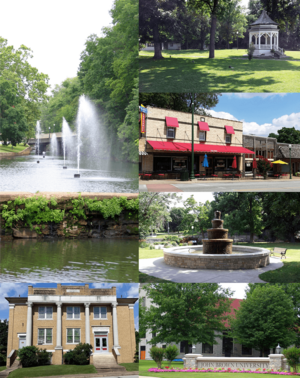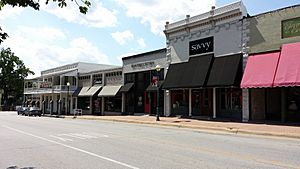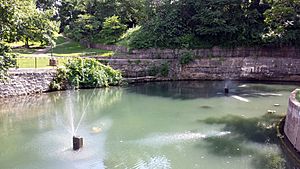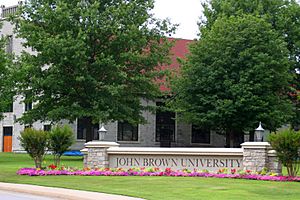Siloam Springs, Arkansas facts for kids
Quick facts for kids
Siloam Springs, Arkansas
|
|||
|---|---|---|---|

Clockwise, from top: Gazebo in City Park, Main Street Siloam Springs, fountain in Twin Springs Park, entrance to John Brown University, Sager Creek Arts Center, fountains in Sager Creek
|
|||
|
|||

Location of Siloam Springs in Benton County, Arkansas.
|
|||
| Country | United States | ||
| State | Arkansas | ||
| County | Benton | ||
| Incorporated | December 22, 1881 | ||
| Government | |||
| • Type | City Administrator | ||
| Area | |||
| • Total | 11.92 sq mi (30.87 km2) | ||
| • Land | 11.75 sq mi (30.43 km2) | ||
| • Water | 0.17 sq mi (0.45 km2) | ||
| Elevation | 1,132 ft (345 m) | ||
| Population
(2020)
|
|||
| • Total | 17,287 | ||
| • Density | 1,471.61/sq mi (568.18/km2) | ||
| Time zone | UTC-6 (Central (CST)) | ||
| • Summer (DST) | UTC-5 (CDT) | ||
| ZIP code |
72761
|
||
| Area code(s) | 479 | ||
| FIPS code | 05-64370 | ||
| GNIS feature ID | 0078364 | ||
Siloam Springs is a city in Benton County, Arkansas, United States, and located on the western edge of the Northwest Arkansas metropolitan area. As of the 2020 census, the population of the city was 17,287. The community was founded in 1882 and was characterized by the purported healing powers of the spring water feeding Sager Creek and trading with nearby Native American tribes. The city shares a border on the Arkansas–Oklahoma state line with the city of West Siloam Springs, Oklahoma, which is within the Cherokee Nation territory. It is home of John Brown University.
Contents
History
Osage Indians were the known first inhabitants of the area. Siloam Springs' first white settlers were of German and Scots-Irish origin. Simon Sager is considered the founder of the town, then known as Hico.
In 2012, the city was named one of the 20 best small towns in America by Smithsonian magazine
Geography
The area is located in the Mid-South region of the country where the southern plains meet the Ozark Mountains. The city sits atop a plateau with many dogwood trees growing across the landscape.
A perennial creek, named after the founder, Sager Creek, flows through the downtown area.
According to the United States Census Bureau, the city has a total area of 11.2 square miles (28.9 km2), of which 11.1 square miles (28.7 km2) is land and 0.077 square miles (0.2 km2), or 0.71%, is water.
Metropolitan area
The Fayetteville–Springdale–Rogers Metropolitan Area consists of three Arkansas counties: Benton, Madison, and Washington, and McDonald County, Missouri. The area had a population of 347,045 at the 2000 census which had increased to 463,204 by the 2010 Census (an increase of 33.47 percent). Siloam Springs is at the extreme western edge of this area, connected to the principal cities by Highway 412.
Climate
The climate in this area is characterized by hot, humid summers and generally mild to cool winters. According to the Köppen Climate Classification system, Siloam Springs has a humid subtropical climate, abbreviated "Cfa" on climate maps.
July is the hottest month of the year, with an average high of 89.1 °F (31.7 °C) and an average low of 68.6 °F (20.3 °C). Temperatures above 100 °F (37.8 °C) are rare but not uncommon, occurring on average twice a year. January is the coldest month with an average high of 44.3 °F (6.8 °C) and an average low of 24.2 °F (−4.3 °C). Highs below 32 °F (0.0 °C) occur on average thirteen times a year, with 2.2 nights per year dropping below 0 °F (−17.8 °C). The city's highest temperature was 111 °F (43.9 °C), recorded on July 14, 1954. The lowest temperature recorded was −24 °F (−31.1 °C), on February 12, 1899.
Precipitation is weakly seasonal, with a bimodal pattern: wet seasons in the spring and fall, and relatively drier summers and winters, but some rain in all months. The spring wet season is more pronounced than fall, with the highest rainfall in May. This differs slightly from the climate in central Arkansas, where the fall wet season is more comparable to spring.
| Climate data for Siloam Springs, Arkansas (1981–2010 normals) | |||||||||||||
|---|---|---|---|---|---|---|---|---|---|---|---|---|---|
| Month | Jan | Feb | Mar | Apr | May | Jun | Jul | Aug | Sep | Oct | Nov | Dec | Year |
| Record high °F (°C) | 77 (25) |
83 (28) |
90 (32) |
91 (33) |
92 (33) |
103 (39) |
111 (44) |
109 (43) |
102 (39) |
96 (36) |
83 (28) |
79 (26) |
111 (44) |
| Mean daily maximum °F (°C) | 45 (7) |
51 (11) |
59 (15) |
69 (21) |
76 (24) |
84 (29) |
89 (32) |
89 (32) |
81 (27) |
71 (22) |
57 (14) |
48 (9) |
68 (20) |
| Mean daily minimum °F (°C) | 23 (−5) |
28 (−2) |
36 (2) |
44 (7) |
53 (12) |
62 (17) |
67 (19) |
66 (19) |
59 (15) |
47 (8) |
36 (2) |
27 (−3) |
46 (8) |
| Record low °F (°C) | −12 (−24) |
−14 (−26) |
−7 (−22) |
20 (−7) |
30 (−1) |
43 (6) |
46 (8) |
42 (6) |
31 (−1) |
20 (−7) |
5 (−15) |
−8 (−22) |
−14 (−26) |
| Average precipitation inches (mm) | 2.27 (58) |
2.20 (56) |
4.32 (110) |
4.31 (109) |
5.20 (132) |
4.84 (123) |
3.54 (90) |
3.35 (85) |
5.05 (128) |
3.68 (93) |
4.82 (122) |
3.42 (87) |
47 (1,193) |
| Average snowfall inches (cm) | 3.3 (8.4) |
1.6 (4.1) |
1.9 (4.8) |
0 (0) |
0 (0) |
0 (0) |
0 (0) |
0 (0) |
0 (0) |
0.1 (0.25) |
0.2 (0.51) |
2.0 (5.1) |
9.1 (23.16) |
| Source: The Weather Channel | |||||||||||||
Demographics
| Historical population | |||
|---|---|---|---|
| Census | Pop. | %± | |
| 1880 | 95 | — | |
| 1890 | 821 | 764.2% | |
| 1900 | 1,748 | 112.9% | |
| 1910 | 2,405 | 37.6% | |
| 1920 | 2,569 | 6.8% | |
| 1930 | 2,378 | −7.4% | |
| 1940 | 2,764 | 16.2% | |
| 1950 | 3,270 | 18.3% | |
| 1960 | 3,953 | 20.9% | |
| 1970 | 6,009 | 52.0% | |
| 1980 | 7,940 | 32.1% | |
| 1990 | 8,151 | 2.7% | |
| 2000 | 10,843 | 33.0% | |
| 2010 | 15,039 | 38.7% | |
| 2020 | 17,287 | 14.9% | |
| U.S. Decennial Census | |||
2020 census
| Race | Number | Percentage |
|---|---|---|
| White (non-Hispanic) | 10,175 | 58.86% |
| Black or African American (non-Hispanic) | 184 | 1.06% |
| Native American | 737 | 4.26% |
| Asian | 345 | 2.0% |
| Pacific Islander | 32 | 0.19% |
| Other/Mixed | 1,477 | 8.54% |
| Hispanic or Latino | 4,337 | 25.09% |
As per the 2020 United States Census, there were 17,287 people, 5,382 households, and 3,980 families residing in the city.
2010 census
As of the census of 2010, there were 15,039 people in 5,138 households with 93.3% of the population in households. The racial and ethnic composition of the population was 76% non-Hispanic white, 0.8% black, 4.6% Native American, 1.6% Asian, 0.2% non-Hispanic reporting some other race, 5.0% from two or more races and 20.8% Hispanic or Latino.
Arts and culture
Annual cultural events
| Event | Time of year | Attendance (approx.) |
|---|---|---|
| Dogwood Festival | April (last weekend) | 30,000 |
| Homegrown Festival | October | 3,000 |
| Siloam Springs Rodeo | June | 10,000 |
| Light Up Siloam Christmas Parade | December (first Saturday) | 6,500 |
| City Fireworks Presentation | July 4 | 6,000 |
| Northwest Arkansas Marching Band Invitational | October | 2,500 |
| JBU Candlelight Christmas Concerts | December | 3,000 |
| JBU Homecoming | October | 1,000 |
| Siloam Springs Music Games (Marching Band Competition) | July | 2,000 |
| Siloam Springs Center for the Arts | All year | 10,000 per year |
Education
In addition to John Brown University, public education is supported by the Siloam Springs School District consisting of:
- Siloam Springs High School (grades 9–12)
- Siloam Springs Middle School (grades 7–8)
- Siloam Springs Intermediate School (grades 5–6)
- Southside Elementary School (grades 3–4)
- Allen Elementary School (grades 1 & 2)
- Northside Elementary School (grades Pre-K & K)
- Siloam Springs Virtual Academy (grades K–12)
Infrastructure
Transportation
Siloam Springs traffic is primarily served by US 412 for east–west travel, connecting the city to Tulsa, Oklahoma, to the west via the Cherokee Turnpike and to Bentonville, Fayetteville, and Springdale, Arkansas, to the east. US 59 runs south from West Siloam Springs to Stilwell and Sallisaw, Oklahoma, while Arkansas 59 runs north to Gravette and south to Van Buren and Fort Smith, Arkansas. Within the city, major routes include Cheri Whitlock Drive, Lincoln Street, Main Street, Mount Olive Street, and University Street.
Smith Field, located east of town, serves small business jets as well as double- and single-engine aircraft. It serves exclusively general aviation operations.
Commercial air transportation is available from Northwest Arkansas Regional Airport, about 21 miles (34 km) to the east-northeast.
Utilities

The city's primary water source is the Illinois River, although some water is purchased from Benton - Washington Regional Public Water Authority, whose source is Beaver Lake. The water is treated with chlorine, and the by-products of this chlorination process are kept compliant with the Arkansas Department of Health standards. Fluoride is added to supplement the naturally occurring amount present prior to treatment.
Wastewater is treated at the Siloam Springs Wastewater Treatment Plant (SSWWTP). Since effluent is discharged into a tributary of the Illinois, the plant's effluent is required to meet the treatment standards of both Arkansas and Oklahoma. The phosphorus load of the Illinois has been subject of controversy in the area, even reaching the United States Supreme Court in 1992. The Environmental Protection Agency (EPA) has classified the Illinois as Section 303(d) of the Clean Water Act, listing it as an "impaired and threatened water" due to the high phosphorus loads. As a result of the applicable strict phosphorus effluent regulations, SSWWTP upgraded its system in 2011. The upgrades also increased capacity 25% to 5.5 million gallons per day (MGD) (14,474 liters per hour). Although presently a traditional biological nutrient removal (BNR) plant capable of meeting the interim phosphorus limit, pilot tests have proven a chemical nutrient removal (CNR) and membrane biological reactor combination to be effective well below the possible future permit limit. However, due to the high cost, these phases have been delayed. Currently, a 3-year study is being conducted to determine the background phosphorus level in the Illinois. The future effluent limits will likely be written following the conclusion of the study. An EPA total maximum daily load (TMDL) study in the watershed is also ongoing.
Notable people
- Duncan Baird, Republican politician from District 96 in Benton County, graduated from Siloam Springs High School
- Jonathan Barnett, Republican politician from District 87 in Benton and Washington counties
- Preston Bynum, a lobbyist in Little Rock, served as the state representative from Siloam Springs from 1969 to 1980
- Mike Flynn, radio personality, hosts the NPR program The Folk Sampler
- Alice Ghostley, actress, spent a number of years in Siloam Springs as a youth
- Jim Winn, Major League Baseball pitcher, went to John Brown University in Siloam Springs
- Jonathan Earl Woods, Republican politician, served as former member of both houses of the Arkansas General Assembly
See also
 In Spanish: Siloam Springs (Arkansas) para niños
In Spanish: Siloam Springs (Arkansas) para niños





